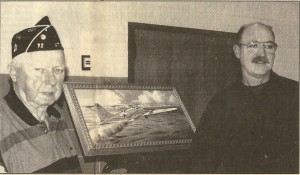By Regina Villiers. Originally published April 29, 1998 in The Suburban Life, added April 14, 2015.

Al Broughton, left, and artist Les LeFevre stand next to LeFerve’s painting portraying the last moments of Broughton’s 35th mission as a tailgunner on the B-17 that crashed into the White Cliffs of Dover during World War II on Aug. 24, 1944.
When Les LeFevre toured a World War II B-17 bomber that flew into Lunken Airport a few years ago, he was deeply moved by the experience.
It would be hard for anyone not to be moved by one of these storied aircraft, nicknamed the “Flying fortress;” but Les, who is an artist, found it doubly moving. He couldn’t erase the picture of it, and all it had endured, from his mind.
He had taken photographs of it that day and decided he would paint it. He started researching the old B-17 and the history behind it. He had been to the White Cliffs of Dover and had taken photographs there. A story started to form in his mind.
From his research, he learned that an aviation painting usually pertains to one actual event, and he remembered that he knew someone who had been a crewmember on a B-17 during World War II, so he contacted this veteran to learn his story.
Al Broughton, who now lives in Madeira, was a tail gunner on a B-17 during WWII. He flew 35 missions before being sent home. He told his stories to Les who decided to paint the story of Al’s final 35th mission.
Here is that story.
On Aug. 24, 1944, Staff Sergeant Alfred Broughton, with the 385th Bomb Group, 550th Squadron, flew his 35th and final mission, as a tail gunner, over Brux, Germany
He knew he’d be flying that day, he said, because he got fried eggs for breakfast. Only on the days you flew, did you get fried eggs.
When he reported, he discovered he was to fly with a brand new crew, except for the waist gunner. It was common practice to send some veteran crewmembers with a new crew the first few times they flew. The pilot and the rest of the crew that day were on their second or third mission. Al does not know their names.
The mission proved not to be a “milk run.” They encountered heavy flak. One engine was completely blown from the bomber, and another engine got hit and caught fire. There were numerous holes in the aircraft, including a big hole just behind the pilot.
The pilot put the plane into a steep dive to suppress the fire, or they would have been consumed by fire.
With only two engines functioning, they limped toward home, toward Great Ashfield, England. Everything that wasn’t tied down was jettisoned into the English Channel, but the White Cliffs of Dover kept rising up in front of them.
The mortally wounded plane could not reach the field. The pilot fought to keep it aloft long enough to reach the coastline, and it crashed upon the White Cliffs of Dover.
All of the crew survived that day, Al says, because of a brave crew and a skilled, courageous pilot.
Al was then sent home and received the Distinguished Flying Cross.
Les portrayed the final moments of that mission in a painting. His painting shows the wounded plane ready to crash into the White Cliffs of Dover.
At a recent meeting of the Madeira Historical Society, Les and Al showed the painting and told its story.
That night, Al also exhibited many items from his days as a B-17 tail gunner. He brought his log, listing the missions he flew. He brought photographs. He brought his Distinguished Flying Cross.
But the most interesting thing he brought was his leather bomber jacket. The back bears an insignia for each of his 35 missions.
In his background research for the painting, Les read many books. He pored over and studied many photographs.
A part of his research was the movie, “The Memphis Belle,” a part of which he showed at the meeting that night.
At the end of the meeting, artist Les LeFevre presented his painting to veteran Al Broughton, as a memento of his final mission in the legendary B-17 Flying Fortress.
The B-17 played a big part in the victory of the Allies in the European theater of World War II. Few of them are left today, and the men who flew them are dwindling in number.
But one of them, former Staff Sergeant Alfred Broughton can still tell his story.
He’s a true hero.